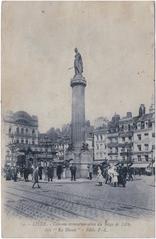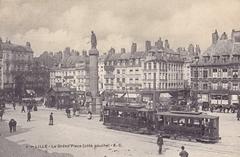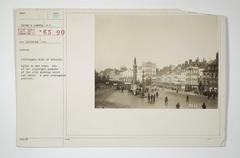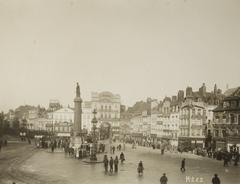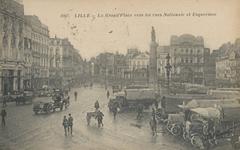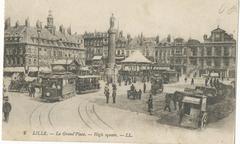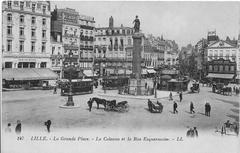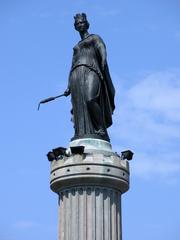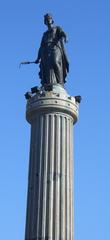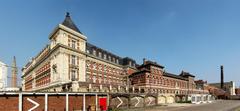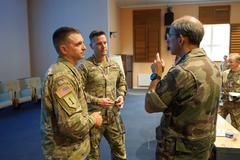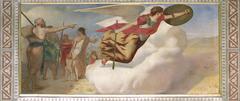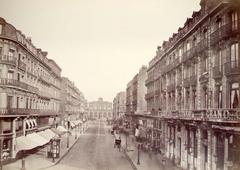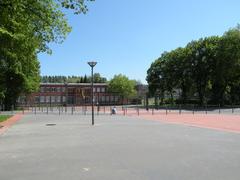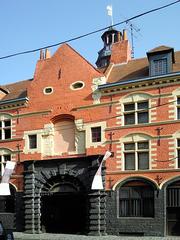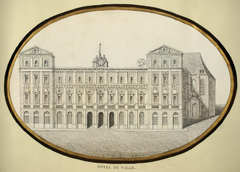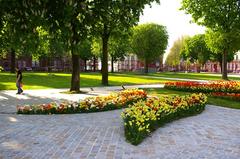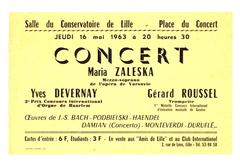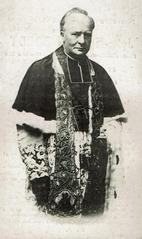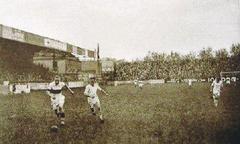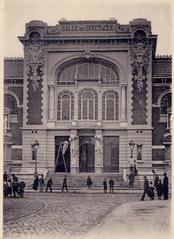
Comprehensive Guide to Visiting Colonne de la Déesse in Lille, France
Date: 24/07/2024
Introduction
The Colonne de la Déesse, or the Goddess Column, stands as an emblematic symbol of resilience and patriotism in the heart of Lille, France. This monumental column, prominently located in the Grand’Place—currently known as Place du Général-de-Gaulle—commemorates the city’s brave defense during the Siege of 1792. The siege was a significant event in Lille’s history, marking a time when the city’s inhabitants, under the leadership of Mayor François André-Bonte, staunchly defended their home against Austrian forces (Wikipedia). The monument’s design by architect Charles Benvignat and the statue sculpted by Théophile Bra not only reflect architectural elegance but also a deep cultural and historical narrative (Nord Découverte).
Erected to honor the 50th anniversary of the siege, the Colonne de la Déesse was inaugurated in 1845 after overcoming numerous challenges (Wandering Wounded). It stands 12.51 meters tall, with a statue of a woman holding a torch, symbolizing Lille’s readiness to defend itself. This statue, crowned with the city’s fortifications, quickly became known as the ‘Goddess,’ a name that endures today (Waymarking).
The Colonne de la Déesse is more than just a historical monument; it is a cultural icon and a central gathering point for both locals and visitors. Surrounded by the vibrant atmosphere of the Grand’Place, the column is a must-see for anyone exploring Lille. This guide will delve into the monument’s rich history, architectural details, visitor information, and nearby attractions, ensuring you make the most of your visit.
Table of Contents
- Historical Background
- Visiting the Colonne de la Déesse - Hours and Tickets
- Nearby Attractions
- Guided Tours and Special Events
- Photographic Spots
- FAQ
Historical Background
The Siege of Lille (1792)
The Colonne de la Déesse commemorates the heroic defense of Lille during the siege of 1792, a pivotal event in the city’s history. On April 20, 1792, the French Legislative Assembly, at the behest of King Louis XVI, declared war on the ‘King of Bohemia and Hungary,’ a title referring to the Emperor of the Holy Roman Empire and his dominions (Wikipedia). Lille, situated on the front lines, faced a significant threat from the Austrian forces.
The siege began on September 29, 1792, at 3 PM, with the Austrian army bombarding the city. Despite the relentless assault, the citizens of Lille, led by their mayor François André-Bonte, mounted a staunch defense. The siege lasted until October 6, 1792, and the city’s resistance was so formidable that the National Convention unanimously passed a decree on October 12, 1792, proclaiming, ‘Lille has well deserved of the fatherland’ (Wikipedia).
The Monument’s Conception and Construction
The idea of erecting a monument to honor Lille’s defense was proposed shortly after the siege. On November 9, 1792, the renowned artist Jacques-Louis David suggested the creation of a lasting monument to commemorate the city’s bravery (Wikipedia). However, it wasn’t until 50 years later, in 1842, that the project gained momentum. The monument was finally inaugurated on October 8, 1845, after overcoming numerous challenges (Nord Découverte).
Architectural and Artistic Details
The Colonne de la Déesse was designed by architect Charles Benvignat and features a statue sculpted by Théophile Bra, a native of Douai (Wikipedia). The column itself stands 12.51 meters tall, resting on a base with a diameter of 3.65 meters. It is made of fluted granite, adding to its imposing presence in the Grand’Place, now known as Place du Général-de-Gaulle (Wikipedia).
The bronze statue atop the column represents a woman holding a ‘boutefeu’ (a torch used to ignite cannon fuses) in her right hand, symbolizing the city’s readiness to defend itself. Her left hand points to an inscription on the pedestal, which quotes Mayor François André-Bonte’s refusal to surrender the city to the Austrian forces on September 29, 1792 (Wikipedia).
Symbolism and Cultural Significance
The Colonne de la Déesse is not just a historical monument but also a symbol of Lille’s enduring patriotism and resilience. The statue’s severe expression and determined posture embody the city’s spirit during the siege. The monument quickly became known as the ‘Column of the Goddess’ following a locally published poem that celebrated its significance (Wikipedia).
In addition to its historical importance, the monument has cultural and artistic value. It is one of Lille’s most recognizable symbols and serves as a central point for various ceremonies and festivals. The column is surrounded by a fountain and a circular basin, added during the construction of an underground parking lot in 1989 (Nord Découverte).
The Cross of War and Modern Additions
The base of the monument now bears the Croix de Guerre, awarded to the city after the Armistice of 1918 to honor its courage during the bombings of October 1914 and the subsequent four years of enemy occupation (Wikipedia). This addition further cements the column’s role as a testament to Lille’s resilience through multiple conflicts.
Anecdotes and Local Lore
The Colonne de la Déesse is also surrounded by intriguing anecdotes. Initially intended to be placed in Place Rihour, the monument was eventually erected in Place du Général-de-Gaulle. This change resulted in the statue’s hand being more than 10 meters away from the inscriptions it was meant to ‘touch,’ and the statue now faces away from the historical enemy positions in the faubourgs of Fives and Saint-Maurice (Nord Découverte).
Another interesting tidbit is that the statue’s face is said to have been modeled after the wife of Louis Bigot-Danel, the mayor of Lille at the time of the monument’s construction (Nord Découverte).
Visiting the Colonne de la Déesse - Hours and Tickets
Visiting Hours
The Colonne de la Déesse is accessible to the public 24/7, allowing visitors to admire the monument at any time of day or night. However, the best time to visit is during daylight hours when the details of the statue and column can be fully appreciated.
Ticket Information
There is no entrance fee to visit the Colonne de la Déesse, making it a budget-friendly attraction for all visitors.
Nearby Attractions
The Colonne de la Déesse is centrally located in Lille, making it an excellent starting point for exploring the city’s other attractions. Nearby, visitors can find the Palais des Beaux-Arts de Lille, one of France’s largest and most prestigious museums, just a 12-minute walk away (Trek Zone). Other notable sites include the Hospice Comtesse Museum, Lille Cathedral, and the bustling Euralille shopping center (Trek Zone).
Guided Tours and Special Events
For those interested in a more in-depth exploration, guided tours are available that provide detailed historical context and anecdotes about the Colonne de la Déesse and its surroundings. Special events and ceremonies are also often held at the monument, especially on significant historical anniversaries.
Photographic Spots
The Colonne de la Déesse offers several excellent photographic opportunities. The best spots include capturing the monument from the front with the Grand’Place as a backdrop, as well as night-time shots when the monument is beautifully illuminated.
FAQ
- What are the visiting hours of the Colonne de la Déesse? The monument is accessible 24/7, but it’s best visited during daylight hours.
- How much are the tickets to visit the Colonne de la Déesse? There is no entrance fee to visit the monument.
- Are guided tours available? Yes, guided tours are available and provide detailed historical context.
- What are some nearby attractions? Nearby attractions include the Palais des Beaux-Arts de Lille, the Hospice Comtesse Museum, and Lille Cathedral.
Conclusion
The Colonne de la Déesse stands as a powerful symbol of Lille’s historical resilience and cultural heritage. Its rich history, architectural beauty, and central location make it a must-visit landmark for anyone exploring the city. Whether you’re interested in history, art, or simply enjoying the vibrant atmosphere of Lille, the Column of the Goddess offers a fascinating glimpse into the city’s storied past. Be sure to visit the nearby attractions and partake in guided tours to enrich your experience. Follow us on social media to stay updated on special events and new articles about Lille’s historical sites.
